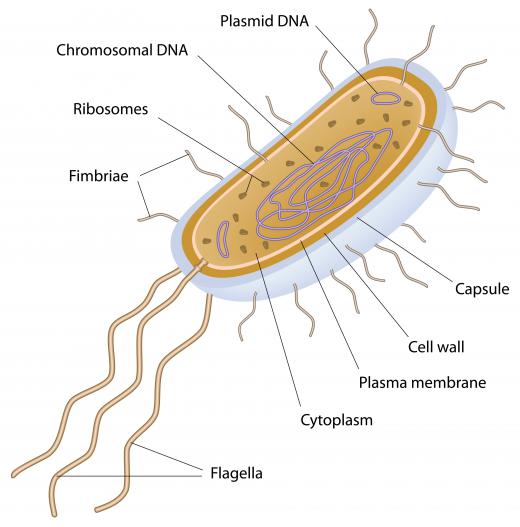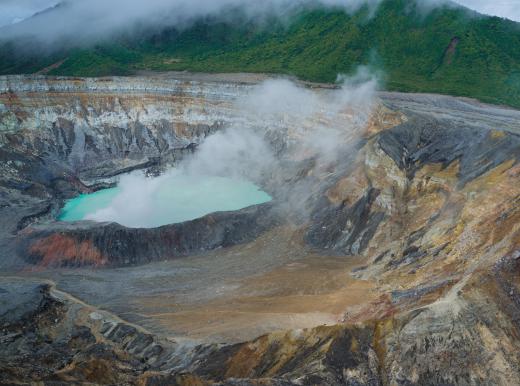What are Archaebacteria?
 Michael Anissimov
Michael Anissimov
Archaebacteria are a type of prokaryote, that is, a unicellular organism without a cell nucleus. They make up the kingdom Archae, one of the main kingdoms of life. These organisms are difficult to classify because they have similarities to both normal bacteria and the larger eukaryotes. In structure, they are like unicellular prokaryotes, but the genetic transcription and translation underlying their creation is similar to that of the more complex eukaryotes.
Able to live in a variety of environments, archaebacteria are known as extremophiles. Certain species are able to live in temperatures above boiling point at 100° Celsius or 212° Fahrenheit. They can also thrive in very saline, acidic, or alkaline aquatic environments. They employ a variety of chemical tricks to accomplish this, with one species, halobacteria, able to convert light into adenosine triphosphate (ATP) or cell energy, using a non-photosynthetic process. Halobacteria live in waters almost completely saturated with salt, and unlike photosynthetic plants, are incapable of extracting carbon from atmospheric carbon dioxide.

Archaebacteria have a size between 1/10th of a micrometer to over 15 micrometers. (A human hair is about 100 micrometers in width.) Some possess flagella, but these are substantially different in structure than the flagella bacteria have. In 1999, Pyrococcus abyssi, one of the toughest archaebacteria on Earth, had its genome sequenced. Further study of its resilience to extreme temperatures is expected to have applications in the biotechnology industry. Archaebacteria are non-pathogenic, living in and around other organisms but not infecting them. Some are able to withstand pressures of above 200 atmospheres, allowing them to thrive deep within the Earth.

Archaebacteria were not recognized as a distinct form of life from bacteria until 1977, when Carl Woese and George Fox determined this through RNA studies. However, the kingdom Archae has a close relationship to the kingdom Eukarya, the two sharing many genetic trees and common traits. One of the first places Archae were discovered was at the boiling hot springs in Yellowstone National Park.
AS FEATURED ON:
AS FEATURED ON:













Discussion Comments
To answer some questions: All bacteria are unicellular. All bacteria are prokaryotic, They are heterotrophs, autotrophs, and decomposers.
What does an archaebacteria have in common with a white blood cell, antibody, and a red blood cell?
I want to know how is it harmful to humans?
I need to know about the respiration of archaebateria.
Some examples of archaebacteria are methanogens,
halophiles and thermoaciophiles.
@anon7593: Archaebacteria live in extreme places like hot springs and hot sulfur springs. Archaebacteria are also autotrophs and use chemosynthesis instead of photosynthesis.
what do they eat?
what is the reason for archaebacteria?
Archaebacteria have a cell wall, it just doesn't have any peptidoglycan, but eubacteria do have peptidoglycan.
Archeabacteria live in extreme conditions where any other living organisms could not survive. that is the difference between archeabacteria and eubacteria.
What is the type of circulatory system that has archeobacteria?
are they heterotrophic or autotrophic?
how can archeobacteria survive without a cell wall?
How are the organisms in archeabateria useful to humans?
whats the taxonomy of an archaebacteria? like what would an example of one be?
Are they heterotroph or autotroph?
How are they important to humans?
why do scientists think that Archaebacteria were the first forms of life on our planet?
Archaebacteria are very similar to prokaryotes. But they differ from the cell wall and the cell membrane. In prokaryotic cell membrane a phospholipid bi layer is present. But in archaebacteria a single layer of phospholipid is available. That's a reason why they could live in very limited resource environments.
do the archaebacteria have endospores?
What was their contribution to life on earth?
are archaebacteria harmful or helpful to our environment?
What do archaebacteria have to do with humans as in diseases and sickness? What do they eat?
Reproduction?
can some body tell me what biology is about?
can somebody help me find the reason why archaebacterias were the first thing to exist on the world?
Help! what are at least five cell structures of an archaebacteria cell?
How do they benefit and or harm the environment?
well, if some archaebacteria can produce ATP without photosynthetic processes. maybe we can make use of this energy to replace car fuel and reduce the harmful pollution that is caused. archaebacteria is a wide sector and must be really taken into consideration.
How would Jesus know? He was born only 2000 years ago.
Jesus begs to differ about Archaebacteria being the first organism.
Where does archeabacteria form?
I need to some some different species of bacteria.
archaebacteria are unicellular which means that they consist only of a single cell. as to some of the other questions, i do not quite know because i am only at high school level, a sophomore. I think that archaebacteria are neither producer or consumer for they are almost like parasites but they do not harm the host or help it. Well, one main reason why we desperate archaebacteria from eubacteria is because archaebacteria can survive at extreme temperatures and climate while eubacteria cannot survive in extreme environments. Example, a eubacteria organism such as a virus and an archaebacteria such as a thermophile differ because the virus would die before the temperature of the water it is in reached boiling point but the thermophile would be fine. I do not understand how or why this is so, but I have a theory that archaebacteria can adapt or acclimate to their environment at a rapid rate, I mean, they've been around for ages. Hey, maybe we could, if we studied them further, we could someday survive extreme temperatures and/or climates without the use of expensive equipment.
please tell me what makes archaebacterias different from cyanobacteria and eubacteria!
are they single celled or multicellular?
My question is either archaebacteria can it be called cury thermal or not?
What r some other types of Archaebacteria?
what are different structures and function of Archaebacteria?
could the genome of Pyrococcus abyssi show us how to change human genomes so we could survive freezing temperatures without expensive equipment?? food for thought
Is Archaebacteria a producer or consumer????
what are the reasons why we separate the archaebacteria from eubacteria?
Post your comments